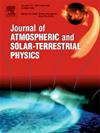Microphysical characteristics of shallow precipitating systems in the southwest monsoon season: An analysis using in-situ and remote sensing observations
IF 1.8
4区 地球科学
Q3 GEOCHEMISTRY & GEOPHYSICS
Journal of Atmospheric and Solar-Terrestrial Physics
Pub Date : 2025-02-27
DOI:10.1016/j.jastp.2025.106484
引用次数: 0
Abstract
The present study examined the microphysical features of the shallow precipitating systems at low (10.04°N, 76.33°E, 20 m above MSL) and mid-altitude (8.45°N, 77.5°E; 400 m above MSL) locations situated on the windward side of the Western Ghats in southwest monsoon 2019. A total of 226 and 336 shallow precipitating systems were identified using radar reflectivity and surface rain rate from the co-located measurements using the micro rain radar and disdrometer instruments in both locations. The average cloud base height of shallow precipitating systems is ∼1 km. An elevated cloud layers (0.8–3.8 km) during long-duration shallow precipitating systems are more prevalent in low-altitude location. Shallow events in the mid-altitude region are characterized by long durations and high surface rain rates. Based on the duration and rain rates, the shallow systems are further classified for in-depth microphysical analysis. The broader raindrop size distribution spectra are clearly observed for the shallow events having higher duration and intensity. The concentration of small size raindrops are higher across all rain categories in the low-altitude location, while the concentration of mid-sized raindrops is notably higher in the heavy rain category indicating an active collision-coalescence process. Light rain events are predominantly characterized by small raindrops (D < 1 mm), whereas moderate and heavy rainfall events are primarily composed of midsize raindrops (1 ≤ D < 3 mm). The Nw-Dm relation for the shallow events in wet (dry) spells suggests that, isolated events mainly occur due to the local orographic effects of the elevated terrains.
西南季风季节浅层降水系统的微物理特征:基于原位和遥感观测的分析
本文研究了低海拔(10.04°N, 76.33°E,海拔20 m)和中海拔(8.45°N, 77.5°E)浅降水系统的微物理特征;海拔400米),位于2019年西南季风西高止山脉的迎风侧。利用雷达反射率和地表雨率,利用微雨雷达和分差仪在两个地点进行同步测量,共确定了226和336个浅层降水系统。浅降水系统的平均云底高度为~ 1 km。在持续时间较长的浅降水系统中,高架云层(0.8-3.8 km)在低空地区更为普遍。中海拔地区浅层事件的特点是持续时间长,地表降雨率高。根据持续时间和降雨速率,进一步对浅层系统进行分类,进行深入的微物理分析。在持续时间和强度都较高的浅层事件中,雨滴大小分布谱明显较宽。在低空位置,小雨滴的浓度在所有降雨类别中都较高,而中等雨滴的浓度在大雨类别中明显较高,表明存在积极的碰撞-合并过程。小雨事件的主要特征是小雨滴(D <;1 mm),而中、强降雨事件主要由中等大小的雨滴(1≤D <;3毫米)。湿(干)期浅层事件的Nw-Dm关系表明,孤立事件主要是由于高架地形的局部地形效应而发生的。
本文章由计算机程序翻译,如有差异,请以英文原文为准。
求助全文
约1分钟内获得全文
求助全文
来源期刊

Journal of Atmospheric and Solar-Terrestrial Physics
地学-地球化学与地球物理
CiteScore
4.10
自引率
5.30%
发文量
95
审稿时长
6 months
期刊介绍:
The Journal of Atmospheric and Solar-Terrestrial Physics (JASTP) is an international journal concerned with the inter-disciplinary science of the Earth''s atmospheric and space environment, especially the highly varied and highly variable physical phenomena that occur in this natural laboratory and the processes that couple them.
The journal covers the physical processes operating in the troposphere, stratosphere, mesosphere, thermosphere, ionosphere, magnetosphere, the Sun, interplanetary medium, and heliosphere. Phenomena occurring in other "spheres", solar influences on climate, and supporting laboratory measurements are also considered. The journal deals especially with the coupling between the different regions.
Solar flares, coronal mass ejections, and other energetic events on the Sun create interesting and important perturbations in the near-Earth space environment. The physics of such "space weather" is central to the Journal of Atmospheric and Solar-Terrestrial Physics and the journal welcomes papers that lead in the direction of a predictive understanding of the coupled system. Regarding the upper atmosphere, the subjects of aeronomy, geomagnetism and geoelectricity, auroral phenomena, radio wave propagation, and plasma instabilities, are examples within the broad field of solar-terrestrial physics which emphasise the energy exchange between the solar wind, the magnetospheric and ionospheric plasmas, and the neutral gas. In the lower atmosphere, topics covered range from mesoscale to global scale dynamics, to atmospheric electricity, lightning and its effects, and to anthropogenic changes.
 求助内容:
求助内容: 应助结果提醒方式:
应助结果提醒方式:


